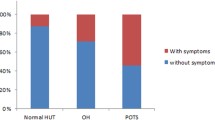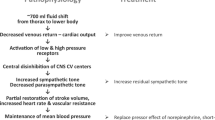Abstract
Orthostatic hypotension (OH), a proxy for sympathetic adrenergic failure, is the most incapacitating sign of autonomic failure. Orthostatic dizziness (OD) is known to be the most common symptom of OH. However, recent studies have demonstrated that 30–39 % of patients with OH experienced rotatory vertigo during upright posture (i.e., orthostatic vertigo, OV), which challenges the dogma that OH induces dizziness and not vertigo. A recent population-based study on spontaneously occurring OD across a wide age range showed that the one-year and lifetime prevalence of OD was 10.9 and 12.5 %, respectively. Approximately 83 % of patients with OD had at least one abnormal autonomic function test result. So far, 11 subtypes of OD have been proposed according to the pattern of autonomic dysfunction, and generalized autonomic failure of sympathetic adrenergic and parasympathetic cardiovagal functions was the most common type. Four different patterns of OH, such as classic, delayed, early, and transient type have been found in patients with OD. The head-up tilt test and Valsalva maneuver should be performed for a comprehensive evaluation of sympathetic adrenergic failure in patients with OD/OV. This review summarizes current advances in OH presenting OD/OV, with a particular focus on the autonomic dysfunction associated with OD.



Similar content being viewed by others
References
Baloh RW, Kerber KA (2011) Clinical neurophysiology of the vestibular system, 4th edn. Oxford, New York, pp 127–147
Consensus Committee of the American Autonomic Society and the American Academy of Neurology (1996) Consensus statement on the definition of orthostatic hypotension, pure autonomic failure and multiple system atrophy. Neurology 46:1470
Robertson D (1999) The epidemic of orthostatic tachycardia and orthostatic intolerance. Am J Med Sci 317:75–77
Mathias CJ, Mallipeddi R, Bleasdale-Barr K (1999) Symptoms associated with orthostatic hypotension in pure autonomic failure and multiple system atrophy. J Neurol 246:893–898
Naschitz J, Rosner I (2007) Orthostatic hypotension: framework of the syndrome. Postgrad Med J 83:568–574
Kim HA, Lee H, Park KJ, Lim JG (2013) Autonomic dysfunction in patients with orthostatic dizziness: validation of orthostatic grading scale and comparison of Valsalva maneuver and head-up tilt testing results. J Neurol Sci 325:61–66
Low PA, Opfer-Gehrking TL, McPhee BR, Fealey RD, Benarroch EE, Willner CL et al (1995) Prospective evaluation of clinical characteristics of orthostatic hypotension. Mayo Clin Proc 70:617–622
Ensrud KE, Nevitt MC, Yunis C, Hulley SB, Grimm RH, Cummings SR, for the Study of Osteoporotic Fractures Research Group (1992) Postural hypotension and postural dizziness in elderly women: the study of osteoporotic fractures. Arch Intern Med 152:1058–1064
Wu J, Yang Y, Lu F, Wu C, Chang C (2008) Population-based study on the prevalence and correlates of orthostatic hypotension/hypertension and orthostatic dizziness. Hypertens Res 31:897–904
Rutan GH, Hermanson B, Bild DE, Kittner SJ, LaBaw F, Tell GS, for the CHS Collaborative Research Group (1992) Orthostatic hypotension in older adults. The cardiovascular health study. Hypertension 19:508–519
Mader S, Josephson K, Rubenstein L (1987) Low prevalence of postural hypotension among community-dwelling elderly. JAMA 258:1511–1514
Tilvis R, Hakala S, Valvanne J, Erkinjunntti T (1996) Postural hypotension and dizziness in a general aged population: a four year follow-up of the Helsinki Aging Study. J Am Geriatr Soc 44:809–814
Nozawa I, Imamura S, Hashimoto K, Nakayama H, Murakami Y (1997) The relationship between orthostatic dizziness and hypotension in male medical students. Auris Nasus Larynx 24:53–58
Nozawa I, Hisamatsu K, Imamura S, Sufimor I, Nakayama H, Murakami Y (1996) Study on orthostatic dysregulation and the Schellong test in healthy young females. ORL J Otorhinolaryngol Relat Spec 58:110–114
Colledge N, Wilson J, Macintyre C, MacLennen W (1994) The prevalence and characteristics of dizziness in an elderly community. Age Ageing 23:117–120
Radtke A, Lempert T, von Brevern M, Feldmann M, Lezius F, Neuhauser H (2011) Prevalence and complications of orthostatic dizziness in the general population. Clin Auton Res 21:161–168
Stewart JM (2013) Common syndromes of orthostatic intolerance. Pediatrics 131:968–980
Freeman R, Wieling W, Axelrod FB, Benditt DG, Benarroch E, Biaggioni I et al (2011) Consensus statement on the definition of orthostatic hypotension, neurally mediated syncope and the postural tachycardia syndrome. Clin Auton Res 21:69–72
Novak P (2011) Assessment of sympathetic index from the Valsalva maneuver. Neurology 76:2010–2016
Kim HA, Yi HA, Lee H (2014) Spectrum of autonomic dysfunction in orthostatic dizziness. Clin Neurophysiol 125:1248–1254
Lee H, Kim HA (2014) Autonomic dysfunction in chronic persistent dizziness. J Neurol Sci 344:165–170
Singer W, Sletten DM, Opfer-Gehrking TL, Brands CK, Fischer PR, Low PA (2012) Postural tachycardia in children and adolescents: what is abnormal? J Pediatr 160:222–226
Gibbons CH, Freeman R (2006) Delayed orthostatic hypotension: a frequent cause of orthostatic intolerance. Neurology 67:28–32
Pezzoli M, Garzaro M, Pecorari G, Cena M, Giordano C, Albera R (2010) Benign paroxysmal positional vertigo and orthostatic hypotension. Clin Auton Res 20:27–31
Jung HJ, Koo JW, Kim CS, Kim JS, Song JJ (2012) Anxiolytics reduce residual dizziness after successful canalith repositioning maneuvers in benign paroxysmal positional vertigo. Acta Otolaryngol 132:277–284
Kim HA, Lee H (2014) Autonomic dysfunction as a possible cause of residual dizziness after successful treatment in benign paroxysmal positional vertigo. Clin Neurophysiol 125:608–614
Jeon EJ, Park YS, Park SN, Park KH, Kim DH, Nam IC et al (2013) Clinical significance of orthostatic dizziness in the diagnosis of benign paroxysmal positional vertigo and orthostatic intolerance. Am J Otolaryngol 34:471–476
Newman-Toker DE, Dy FJ, Stanton VA, Zee DS, Calkins H, Robinson KA (2008) How often is dizziness from primary cardiovascular disease true vertigo? A systematic review. J Gen Intern Med 23:2087–2094
Choi JH, Seo JD, Kim MJ, Choi BY, Choi YR, Cho BM et al (2015) Vertigo and nystagmus in orthostatic hypotension. Eur J Neurol 22:648–655
Choi JH, Yang TI, Cha SY, Lee TH, Choi KD, Kim JS (2010) Ictal downbeat nystagmus in cardiogenic vertigo. Neurology 75:2129–2130
Aoki M, Sakaida Y, Tanaka K, Mizuta K, Ito Y (2012) Evidence for vestibular dysfunction in orthostatic hypotension. Exp Brain Res 217:251–259
Yates BJ, Bronstein AM (2005) The effects of vestibular system lesions on autonomic regulation: observations, mechanisms, and clinical implications. J Vestib Res 15:119–129
Yates BJ, Miller DM (2009) Integration of nonlabyrinthine inputs by the vestibular system: role in compensation following bilateral damage to the inner ear. J Vestib Res 19:183–189
Sugiyama Y, Suzuki T, Yates BJ (2011) Role of the rostral ventrolateral medulla (RVLM) in the patterning of vestibular system influences on sympathetic nervous system outflow to the upper and lower body. Exp Brain Res 210:515–527
Yates BJ, Bolton PS, Macefield VG (2014) Vestibulo-sympathetic responses. Compr Physiol 4:851–887
Whitman GT, Yates BJ (2015) Orthostatic intolerance in acute vestibular neuritis. Mayo Clin Proc 90:308–309
Freeman R (2003) Treatment of orthostatic hypotension. Semin Neurol 23:435–442
Low PA, Gilden JL, Freeman R, Sheng KN, McElligott MA (1997) Efficacy of midodrine vs placebo in neurogenic orthostatic hypotension. A randomized, double-blind multicenter study. Midodrine study group. JAMA 277:1046–1051
Kaufmann H, Freeman R, Biaggioni I, Low P, Pedder S, Hewitt LA, NOH301 Investigators et al (2014) Droxidopa for neurogenic orthostatic hypotension: a randomized, placebo-controlled, phase 3 trial. Neurology 83:328–335
Biaggioni I (2015) Treatment: special conditions: orthostatic hypotension. J Am Soc Hypertens 9:67–69
Author information
Authors and Affiliations
Corresponding author
Ethics declarations
Conflict of interest
The authors declared that they have no conflict of interests. Dr. Lee serves on the editorial boards of Frontiers in Neuro-otology, Research in Vestibular Science, and Current Medical Imaging Review. Drs. Kim and Yi report no disclosures.
Additional information
H.-A. Kim and H.-A. Yi equally contributed as co-first authors to this work.
Rights and permissions
About this article
Cite this article
Kim, HA., Yi, HA. & Lee, H. Recent advances in orthostatic hypotension presenting orthostatic dizziness or vertigo. Neurol Sci 36, 1995–2002 (2015). https://doi.org/10.1007/s10072-015-2363-2
Received:
Accepted:
Published:
Issue Date:
DOI: https://doi.org/10.1007/s10072-015-2363-2




